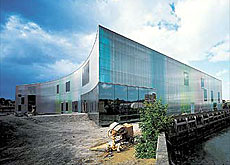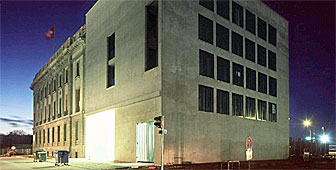Building bridges to New York

Town planners in New York City are being urged to follow Switzerland's lead in urban redevelopment and use it as a model for rejuvenating the city's public spaces.
A month-long tribute to contemporary Swiss architecture at the city’s renowned Van Alen Institute is showcasing projects ranging from cable cars to bridges.
The non-profit organisation, which is “committed to improving the design of the public realm in New York”, regularly hosts architectural competitions, workshops, and public forums.
It uses exhibitions like the current show, “The Swiss Section”, to lobby policy makers.
The show highlights contemporary Swiss architectural projects – some completed and others still on the drawing board – in the public sector.
Put together by guest curator, Nina Rappaport, the emphasis is on the “infrastructure of movement”: railway stations, signal boxes, cable cars and bridges.
“We want to show young architects here that you can design everything from bridges to railroad and tram stations,” Rappaport told swissinfo.
Design element
Rappaport says Switzerland has made a commitment to “building well-designed transit infrastructure for cars, planes, trains and funiculars… and [places them in the] foreground rather than ignore or hide them from view”.
Ray Gastil, the director of the Van Alen Institute, says the Swiss have proved that no structure has to be purely utilitarian.
“It always has to have a certain design element to make it amenable to human occupation,” he says.
“That’s a very important and current element in New York right now as it struggles with its own building issues.”
Taking risks
By comparison, Rappaport and Gastil agree there is an unwillingness in New York to take these kinds of risks.
“In Switzerland and Europe, you have architectural competitions open to everyone and by doing that you get innovative designs,” says Rappaport.
As an example, she cites the Zurich railway station and its new platforms.
“It’s almost equivalent to a tram station but on a larger scale,” she explains.
“You can walk in and out easily because there’s a flow. There’s no hesitation, you just find your way onto the track and you can easily go from the inside to the outside at both sides of the station, without any interruption.
“And it’s really at street level. It’s part of the city,” she adds.
Example
Gastil says projects like the redevelopment of Zurich railway station show the way forward for New York.
“There are regions in the city that have suffered 30 years of decline and now are trying to be revived,” he says.
“So Switzerland sets the bar high for New Yorkers. There are opportunities for serious design even for very straightforward utilitarian projects.”
Many architects and engineers in New York City are still reeling over the controversial selection process for the redevelopment of the World Trade Center site.
In addition, city coffers are bare and hopes are dwindling that money can be found for the innovative or creative redevelopment of the city’s public spaces and infrastructure.
Gastil says, however, that it is possible in New York to turn to the private sector to find funding for public projects, and he hopes the Swiss exhibition will show how it can be done.
swissinfo, Dale Bechtel in New York
The Swiss Section exhibit is part of the “swisspeaks” festival in New York.
The exhibition runs until April 23 at New York’s Van Alen Institute.
The Institute is “committed to improving the design of the public realm”.
The exhibition, the Swiss Section, is organised by themes: Between, Together, Across, Through, Up/Down.
It features projects that move people or assist in their movement, from railway stations, to funiculars, signal boxes and tunnels and bridges.
The guest curator, Nina Rappaport, has displayed, in her words, the “newest, freshest projects” and has “discovered” the young, innovative Swiss architects behind them.

In compliance with the JTI standards
More: SWI swissinfo.ch certified by the Journalism Trust Initiative













You can find an overview of ongoing debates with our journalists here . Please join us!
If you want to start a conversation about a topic raised in this article or want to report factual errors, email us at english@swissinfo.ch.